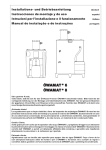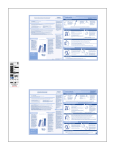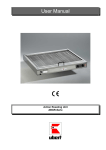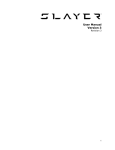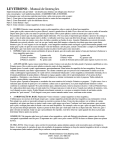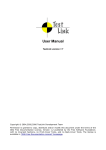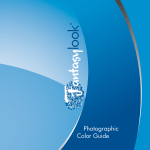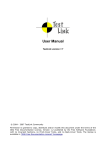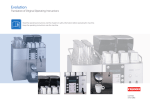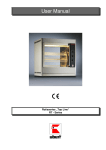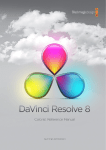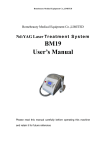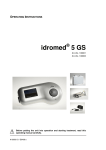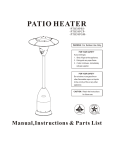Download Instructor`s manual
Transcript
USER’S MANUAL CONTENTS PAGE 1. Hair Color and artease®colors 3 2. artease®colors – Answers to All Questions 4-5 3. The System 6 4. Numbering System 7 5. The Color Chart 8-11 6. artease®peroxide 12 7. How To Use 7.1 Mixing artease®colors 7.2 Application 7.3 Development Time 7.4 Rinsing 7.5 Follow-Up Care 7.6 artease®cream BLEACH 7.7 artease®powder BLEACH 7.8 artease®color BLEACH 14 14 14 15 15 16 17 17 8. Guidelines 8.1 Covering Gray/White Hair 8.2 Pre-Pigmentation 8.3 Virgin Application 8.4 Tone on Tone and Darker Levels 8.5 Lightening 1 to 4 Levels 8.6 Lightening 4 or More Levels 8.7 Lightening with Ultra Lights 8.8 Lightening Options 8.9 Lighten Color Treated Hair 8.10 New Color Nuance 8.11 Lightening Summary 8.12 Darken Color Treated Hair 8.13 Guidelines to Deepen/Darken Previously Colored Hair 18 19 19 20 21 21 22 23 23 24 25 26 26-27 27 Notes 28-31 2 Revised on: October 27, 2008 USER’S MANUAL 1. HAIR COLOR AND ARTEASE COLORS ® Inspiration – Individuality – Creativity Throughout the ages hair has been an inspiration for men and women. It is a major factor that positively influences activities, charm and fascinations. We love to change our appearance, follow trends and events; Business-like and straight during the day, sensual and sexy in the evening. Freedom, constant change, lust for life, the desire of wellness and beauty are the inspirations of the development of artease®colors. artease®colors distributes only products of the highest quality and to the latest technical standards, to meet the demands of the professional hairdresser and colorist. The professional hairdresser and colorist has to be able to meet the demands of a descriminating clientele, concerning quality, result, health and safety. artease®colors’ responsibility is to transmit fundamentaly sound information. These statements are made by a technically developed and experienced company. artease®colors is committed to scientifically sound research. The information in this book is based on these principles. 3 Revised on: October 27, 2008 USER’S MANUAL 2. ANSWERS TO ALL QUESTIONS artease®colors an exceptional product of the highest quality. artease®colors meets the highest expectations thanks to it’s unique Three-WheatProtein formulation. The three proteins differ in size making the color and lightening processes exceptionaly gentle to the hair. This enables artease®colors to penetrate the hair structure more effectively resulting in healthy beautiful hair. Even chemically sensitized hair has a soft, satin sheen. artease®colors guarantees brilliant and natural looking colors, thanks to the high quality and purity of its ingredients. Natural Tones do not have a “green” sheen. A combination of selected, long lasting KUPPLER* color pigments (99% unoxidized), cover gray/white hair up to 100%. Very predictable color results. The ammonia content is one of the lowest of all the color products available. Mix artease®colors cream color, which consists of 92% natural extracts, with artease®peroxide. The result is a creamy, easy to apply hair color that delivers healthy, silky-shiny hair. artease®colors is a permanent and demi-permanent cream hair color of the highest quality with the latest technological developments that satisfies the highest demands: • Extremely mild and gentle • Even color results • 100% gray coverage • Predictable and long lasting color results Thanks to a great palette of brilliant and true Natural Tones, artease®colors is a multifaceted product. Natural-Hair Lightening with artease®colors • 3 levels lift with artease®colors base colors • 4 levels lift with Ultra Lights (12/0, 12/1, 12/11, 12/3, 12/7) • 5 levels lift with Ultra Lights plus Lightener (000) • 4 -6 levels lift with artease®cream BLEACH • 8 levels lift with artease®powder BLEACH Silky-Shine complex is unique, ensuring great comb-ability and shine. *KUPPLER color pigments: Color affecting materials in oxydation-coloration. They connect themselves with the developer molecules and thereby nuance the color of the pigment. The pigments do not dissolve, like sugar in liquids, but adhere and stretch out. 4 Revised on: October 27, 2008 USER’S MANUAL 1. ANSWERS TO ALL QUESTIONS Mixing and Application artease®colors • • • One tube of artease®colors contains 60 ml 63 shades + 5 Ultra Lights + 3 Special Toners + 1 Lightener (000) + 4 Concentrates + 5 Reflex Additives (Mixtones) + 4 Boosters Each shade delivers a predictable, even color result, when mixed with the exact amount of artease®peroxide Mixing Ratio 1:1(1 part hair color+1 part artease®activator 1.9%-7 vol. or 1 part artease®peroxide 3%-10 vol., 6%-20 vol., 9%-30 vol., 12%-40 vol.) Mixing Ratio Ultra Lights 1:2 (1 part hair color + 2 parts artease®peroxide 9%-30 vol., or 12%-40 vol.) Mixing Ratio Lightener 000 1:1:2 (1 part Ultra Lights + 1 part 000 + 2 parts 12%-40 vol. artease®peroxide) this achieves an additional level of lift. Mix artease®colors and artease®peroxide for consistent, perfect color results. • Easy to use • Long lasting color results • 100% gray coverage Bleach and Lightner Assortment • artease®cream BLEACH • artease®powder BLEACH • artease®color BLEACH • Fire Red • Copper Red • Copper Blonde • Copper Orange 5 Revised on: October 27, 2008 USER’S MANUAL 3. THE SYSTEM artease®colors system is the result of stringent quality controls. The well-balanced combination of artease®colors ingredients makes formulating, mixing and application simple, creating a product that does not run or drip This multi-dimensional professional product meets all the requirements of today’s salons concerning reliability, client satisfaction and profit. The exact combination and mixing of artease®colors (pigments, care and activating ingredients) and artease®peroxide (care-ingredients, and peroxide), initiates a series of processes that are fundamental for great hair color. How it Works • • • Opening of the cuticle (surface of hair) Absorption of the color molecule in the hair Release of oxygen The release of oxygen initiates: • Diffusion, lightening of natural melanin • Oxidation and color deposit Note: 100% results are achieved when using artease®colors together with artease®peroxide. artease®colors + a) Color pigment b) Protecting cream base c) Ammonium hydroxide* artease®peroxide = Color a) even release of oxygen b) Care ingredients a) Brilliance b) Even result c) Long lasting *Ammonium hydroxide activates oxidation and opens cuticles 6 Revised on: October 27, 2008 USER’S MANUAL 4. THE NUMBERING SYSTEM artease®colors shades are identified through a number system. Level System Level 2 Level 10 Level = the lightness or darkness of a color All hair colors can be placed on a scale from 2-10 2 = black (the darkest); 10 = ultra light blond (the lightest) The artease®colors numbering system is identified by 3 - 4 numbers The first number = Level The second number = Primary color direction The third number = Secondary color direction The fourth number = Intensity (Placed in front of level number) Second Number Primary Color Direction (e.g. gold) First Number Color Level (e.g. blonde) 7/37 artease®colors Third Number Secondary Color Direction (e.g. Brown) All colors are intermixable. This provides an endless variation of colors. 7 Revised on: October 27, 2008 USER’S MANUAL 5. THE COLOR CHART The color chart, aside from being an invaluable communication tool with clients, is the ultimate support for the hairdresser to achieve the best color results: level, tone, application, formulation, choice of peroxide strength. Color Direction Natural: /0 (primary pigment – blue). Ideal to achieve depth in levels and improve gray coverage. Ash: /1(primary pigment – gray-green). Ideal to neutralize unwanted red-orange (copper) effects. To improve gray coverage, mix with Natural Tones. Intensive Ash: /11 (primary pigment – green-blue). Ideal to neutralize intensive Gold (yellow-yellow) effects. To improve gray coverage, mix with Natural Tones. Gold: /3 (primary pigment – yellow). Ideal to achieve natural gold tones. To improve gray coverage, mix with Natural Tones. Gold-Brown: /37 (primary pigment – yellow-brown). Ideal to achieve deep gold tones. To improve gray coverage, mix with Natural Tones. Red: /4 (primary pigment – red-orange). Ideal to achieve copper-red tones. To improve gray coverage, mix with Natural Tones. Copper-Gold: /43 (primary pigment – red-orange-yellow). Ideal to achieve deep tones with red-gold reflex. To improve gray coverage, mix with Natural Tones. Intensive Red: /44 (primary pigment - red-orange-red). Ideal to achieve very intensive copper tones with a lively red reflex. To improve gray coverage, mix with Natural Tones. Red-Mahogany: /45 (primary pigment – red). Ideal to achieve cool reds. To improve gray coverage, mix with Natural Tones. 8 Revised on: October 27, 2008 USER’S MANUAL 5. THE COLOR CHART Red-Violet: /46 (primary pigment – red-violet). Ideal to achieve cool reds. To improve gray coverage, mix with Natural Tones. Red-Brown: /47 (primary pigment – red-brown). Ideal to achieve cool reds. To improve gray coverage, mix with Natural Tones. Intensive Mahogany: /55 (primary pigment – red-red). Ideal to achieve very intense mahogany tones with a lively reflex. To improve gray coverage, mix with Natural Tones. Violet: /6 (primary pigment - blue-red). Ideal to achieve deep cool violets. Violet Mahogany: /65 (primary pigment – violet-red). Ideal to achieve deep violet tones. To improve gray coverage, mix with Natural Tones. Brown: /7 (primary pigment – brown). Ideal to achieve natural beige-brown tones. To improve gray coverage, mix with Natural Tones. Brown Gold: /73 (primary pigment – brown-yellow). Ideal to achieve natural gold brown tones. To improve gray coverage, mix with Natural Tones. Brown Mahogany: /75 (primary pigment – brown-red). Ideal to achieve natural cool brown tones. To improve gray coverage, mix with Natural Tones. Intensive Brown: /77 (primary pigment – brown-brown). Ideal to achieve rich natural brown tones. To improve gray coverage, mix with Natural Tones. Blue: /8 (primary pigment – blue). Ideal to achieve deepest black tones. 9 Revised on: October 27, 2008 USER’S MANUAL 5. THE COLOR CHART Ultra Lights Ideal to lift up to four levels Ultra Light Blonde 12/0 Ultra Light Ash Blonde 12/1 Ultra Light Ash Intensive Blonde 12/11 Ultra Light Golden Blonde 12/3 Ultra Light Blonde Brown 12/7 Mixing Ratio: Ultra Lights 1:2 with 9%-30 vol., 12%-40 vol. artease®peroxide. Development Time: 45-60 minutes – always check Special Toners Silver: 12/81 (primary pigment blue-ash). Ideal to achieve silver tones on pre-lightened hair. Pearl: 12/88 (primary pigment blue). Ideal to achieve pearl tones on pre-lightened hair. Centre: 12/89 (primary pigment blue-gray). Ideal to use for extra drabbing effect on pre-lightened hair. Mixing Ratio: 1 part Special Toner to 1:1 to 1:3 7 vol., 3% artease®activator or 10 vol. artease®peroxide Development Time: Varies depending upon intensity (5 minutes – 15 minutes) Note: watch carefully! Reflex Additives(Mixtones) Can be added to every shade to enhance the nuance of the shade. The color appears brighter and has more brilliance. Mixing Ratio: 1 part mixtone, 5 parts color Case study: 10g 0/66 + 50g 3/6 + 60ml 6%-20 vol., 9%-30 vol., 12%-40 vol. (or 120ml 1.9%-7 vol., or 3%-10 vol., for demi-permanent color) Important: Mixtones require peroxide and have to be included in the formulation 10 Revised on: October 27, 2008 USER’S MANUAL 5. THE COLOR CHART Boosters Enhance the nuance, and can be added to every shade. Fashion-shades appear deeper and richer. Mixing ratio: 1part booster, 5 parts fashion shade. Case study: 10g 034 + 50g 9/34 + 50ml 6%-20 vol., 9%-30 vol., or 12%-40 vol. (demicolor add 100ml 1.9%-7 vol., or 3%-10 vol.) Important: No additional peroxide needs to be added. Concentrates (Correctors) Used to correct unwanted color results and are predominantly mixed with Natural shades 001 > corrects copper and red color directions 003 > corrects violet color directions 004 > corrects green color directions 006 > corrects golden color directions Mixing Ratio: 1 part Corrector, 5 parts Natural shade Case study: 10g 003 + 50g 9/0 + 60ml 1.9%-7 vol., or 3%-10 vol Important: Concentrates require peroxide and have to be included in the formulation 4.6 Lightener (000) Has the highest ammonia content of all artease®colors. Lightener 000 can be added to any shade. The shade will be between ½ to one levels lighter. Mixing Ratio 1 part 000, 1 part fashion or natural shade Case Study 30 g 000 + 30g 12/0 + 120 ml 9%-30 vol. or 12%-40 vol. Note: For “soft” diffusion of natural hair, mix 1 part 000 + 2 parts artease®peroxide, 6%-20 vol., or 9%-30 vol. This gives a natural lightening effect. 11 Revised on: October 27, 2008 USER’S MANUAL 6. artease peroxide ® Highly stabilized peroxide. Ph factor 2.5 to 3.5. In contrast to most oxidation emulsions, artease®peroxide releases oxygen gradually and consistently making artease®peroxide extremely gentle to the hair structure. Enriched with high quality waxes, artease®peroxide protects the hair structure during the chemical process, enhancing the quality of the color. Shiny, vibrant and balanced hair color is the result. Depending on the desired color result, artease®peroxide is available in four strength levels + artease®activator. Mixing Ratio artease®colors 1:1 artease®colors 1:1 artease®colors 1:1 artease®colors 1:1 artease®colors Ultra Lights 1:2 artease®peroxide artease®activator 1.9%-7 vol. 3%-10 vol. 6%-20 vol. 9%-30 vol. 12%-40 vol. 12%-40 vol. Degree of Lift Tone on tone 1 level 2 levels 3 levels 4 levels + 1* The following processes are the result of mixing artease®peroxide with artease®colors: • • Color development: the color intermediaries oxidize, color develops Lightening: Ammonia and peroxide release oxygen. This causes a diffusion (lightening) of natural melanin in the hair. *Add 000 Lightener 12 Revised on: October 27, 2008 USER’S MANUAL 7. HOW TO USE 7.1 Mixing artease®colors Please note: • Do not use metallic bowls, cups etc. • Use immediately after mixing • Use scales or measuring glass for exact quantities Mixing Ratio artease®colors 1:1 1 part artease®colors + 1 part artease®peroxide Ultra Lights 1:2 1 part artease®colors Ultra Lights + 2 parts artease®peroxide Lightener (000) 1:1 1 part artease®colors + 1 part artease®peroxide Lightener (000) with Ultra Lights 1:1:2 1 part artease®colors Ultra Lights + 1 part Lightener (000) + 2 parts artease®peroxide Special Toners 1:1 – 1:3 1 part artease®colors Special Toners 1 part to 3 parts artease®peroxide The entire artease®colors product line is very easy to use, but requires a disciplined work ethic. Rest assured artease®colors are dependable, versatile and professional. 13 Revised on: October 27, 2008 USER’S MANUAL 7. HOW TO USE 7.2 Application • Section hair • Use mixed color immediately, so that the oxidation can take place on the hair completely. Pay special attention to the application. All you need is careful attention to detail and care, excellent results are guaranteed. • Take thin sections • Apply thoroughly, make sure all hair is covered • Exact measurements are essential • On tone on tone as well as darker colors apply to most resistant hair first, i.e. temples, front hair line • When lightening, bleaching, begin application where melanin concentration is greatest, i.e. nape, back of head. 7.3 Development Time Development time varies according to desired color result (see table). Development time Result 30 minutes 100% gray coverage, tone on tone, darker 30-40 minutes 30-45 minutes 30-50 minutes 20 minutes 100% gray coverage, Lightening 1-2 levels 100% gray coverage, Lightening 2-3 levels 100% gray coverage, Lightening 3-4 levels Demi-permanent coloring Development time can be shortened up to 50%, when using color processors (Rollerball, Klimazone etc.). To avoid scalp irritation, heat is not recommended, when using Ultra Lights. The effects of insufficient development time • Color may fade quicker • Coverage of gray hair may be too translucent • Target level of lightening may not be achieved • Underlying warmth may be left exposed when lightening or toning 14 Revised on: October 27, 2008 USER’S MANUAL 7. HOW TO USE 7.4 Rinsing Rinsing of color is of great importance and should be done with great care, in order to avoid: • • • Unwanted staining of hair (highlights, dimensional coloring) Color residue on scalp and hair Scalp, skin irritations The following steps are recommended: 1. Gently emulsify color and remove from hairline. Do not massage scalp vigorously. artease®colors contains cleansing agents that help to remove the color from hairline and scalp. Do not add water at this point, this would dilute the effectiveness of the cleansing agent. It would become more difficult to clean hairline and scalp. 2. As soon as color residue is removed from hairline and scalp, add water and emulsify. Rinse till water runs clear. 3. If desired, follow with a light second shampoo. Rinse and towel dry. Use a shampoo for color treated hair. 7.5 Follow-Up Care Choose color save conditioner or color save treatments. Do not use strong reconstructing “deep conditioners” right after color services. 15 Revised on: October 27, 2008 USER’S MANUAL 7. HOW TO USE 7.6 artease®cream BLEACH Special size, 500 g (17.63 oz.) artease®cream BLEACH is a blonding paste with a specially developed shine protector, for brilliant color results. The cream is enriched with re-structurizing protective oils suitable for all high-lightening techniques - easy to use. Directions: Use a non-metallic bowl. 1 part artease®cream BLEACH 2 parts artease®activator 1.9% - 7 vol., or artease®peroxide 3% - 10 vol., 6% - 20 vol., 9% - 30 vol., 12% - 40 vol. (Depending on desired lift) Mix to a creamy consistency and apply with desired technique. Before applying toners, gently shampoo and condition in order to neutralize the hair. How to use Depending on desired lift use: 1,9%-7 vol., 3%-10 vol., 6%-20 vol., 9%-30 vol.,12%-40 vol. Bleach-wash Mixing ratio Development time 20 – 60 minutes Check frequently No heat! 1:2 25g artease®cream BLEACH 10ml shampoo 50ml artease®peroxide 5 – 10 minutes Check frequently Note: Because of the conditioning ingredients, artease®cream BLEACH is ideal for lightening chemically stressed hair. Caution: Avoid contact with eyes. If contact occurs, thoroughly rinse with water. Do not use to bleach eyelashes or eyebrows. Always close lid. Keep out of reach of children. 16 Revised on: October 27, 2008 USER’S MANUAL 7. HOW TO USE 7.7 artease®powder BLEACH Suitable for all lightening techniques (highlights, overall blonding, and lightening. Up to 8 levels of lift. Mixing Ratio is variable, from 1:1 to 1:2 Note: artease®activator 1.9%-7 vol. is for a very gentle bleaching process. Bleaching action is very fast. A little goes a long way. No heat! Special ingredients: Silica – protects and nourishes the scalp. 7.8 artease®color BLEACH Is available in the following nuances: Fire-Red, Copper-Red, Copper-Blond and Copper-Orange. • • • • • One step lightening and pigmenting For high-lights and dimensional color only Recommended for dark or black tinted or natural levels Not recommended for gray/white or bleached hair Up to 6 levels of lift Mixing Ratio: 1:2 Note: Extreme brilliance and long lasting when mixed with artease®activator 1.9% - 7 vol., 5-20 minutes. Note: Check frequently, no heat! 17 Revised on: October 27, 2008 USER’S MANUAL 8. GUIDELINES To always have a successful color experience and avoid mistakes, it is essential to follow these guidelines. 6 Steps To Perfect Color Formulation • • • • • • Determine the natural level Determine the desired level Determine the color direction Determine the % of gray/white hair Determine the texture of the hair, i.e., fine, medium or coarse Determine what hair needs to be lightened or darkened The following questions also need to be determined. • • • What is the darkest level (of the clients hair) to achieve the desired depth of color? Can the desired level be reached? What level and tone can be achieved in one color process, or are other methods needed i.e. bleaching, color removal, pre-pigmenting etc.? The existing hair color (or lack of it) is the single most important factor, influencing the outcome of the color result, regardless of the method used. Choices are: • • • Color hair darker Maintain level and tone Lighten hair Most common services are: • • • • 18 Covering gray hair Change natural hair color Change color of previously colored hair Change color reflex Revised on: October 27, 2008 USER’S MANUAL 8. GUIDELINES 8.1 Covering Gray/White Hair People change their hair color for various reasons. One of the main reasons is to maintain a youthful appearance. The desire to cover gray hair is paramount. artease®colors Natural and Natural Plus series are specifically designed to cover gray/white hair to the desired level. By adding Reflex Additives (Mixtones), desired reflections can be achieved. For correct results, it is necessary to: • • • • Determine the desired level and tone Determine the % of gray/white hair Mix artease®colors Natural series with the desired Reflex Additive Determine peroxide strength Depending on the desired result (gray blending, lift and deposit, or deposit only) 1.9% - 7 vol., 3 % - 10 vol., 6% - 20 vol., 9% - 30 vol. is used. Mixing ratio of Natural and Natural Plus series and Reflex Additive is determined by the % of gray hair. By adding more Reflex Additive the color result will be brighter and the desired reflex more visible. Increase the amount of the Natural series to achieve a deeper tone, regardless of level. Attention: Consider % gray/white in temple and hairline areas 8.2 Pre-Pigmentation Pre-pigmentation can be used on very resistant gray/white hair. Pre-pigmentation has two predominant functions: • • Pre-softening of cuticle Color pigments are deposited on hair, resulting in a light stain. Take a small amount of color (do not add peroxide), one to two levels lighter than desired level, and apply to resistant hair. Avoid contact with skin. Let sit for 10 minutes, do not rinse out. Apply desired color formulation to hair. artease®colors /3, /43, /46, /73, /75 /77 are especially suitable for pre-pigmentation. 19 Revised on: October 27, 2008 USER’S MANUAL 8. GUIDELINES 8.3 Virgin Application Three steps are vital to consider when formulating color for the first time. • Natural level • Desired level • Length of hair The hair length is easily underestimated, especially when lightening hair. Different textures and hair structures need to be factored in. 1. The surface temperature on the ends is lower. Temperature at the root area is approx. 96 degrees and decreases towards the ends, where the temperature is only approx. 68-72 degrees. 2. Hair mostly consists of keratin. The keratin structure in mid length and ends is harder. As the basic substance, it is layered and forms the hair structure. This structure (if not influenced by outside forces) in the mid-length and ends, is much more resistant to effects of chemical products. This can create problems, since the color product reacts differently to different temperatures and hair structures than it is designed to do. This results in an uneven color result – the root area is always lighter or brighter, the ends always darker or duller. Various option of virgin application is available • • • 20 Tone on tone or darker color Lighten 1 to 4 levels Lighten 4 or more levels with Ultra Lights + Lightener (000) artease®cream BLEACH, artease®powder BLEACH Revised on: October 27, 2008 USER’S MANUAL 8. GUIDELINES 8.4 Tone on Tone and Darker Levels Determine desired level and choose peroxide strength. Mix artease®colors with artease®peroxide (1.9% - 7 vol., 3 % - 10 vol.) and apply immediately from re-growth to ends. Develop for 20–30 minutes, rinse and use aftercolor. 8.5 Lightening 1 to 4 Levels When hair is lightened more than one level, chemically and/or physically, problems can arise. In addition, if hair is longer than 2 inches, the color may be lighter in the regrowth area compared to the mid-length and the ends. artease®colors solves these problems by formulating color with a higher level of peroxide for mid-length and ends, and a lower level of peroxide for the re-growth area. Correct lightening of all parts of the hair is determined by: • • • Desired artease®colors shade selected Natural level Determine peroxide strength. The difference between natural level and target color is dictated in large part by peroxide strength (6%-20 vol., 9%-30 vol., and 12%-40 vol.). 1) Application to mid-length and ends • • Mix artease®colors selected shade with higher volume artease®peroxide then selected for the re-growth area i.e. if 9%-30 vol.is selected for regrowth, use 12%-40.vol. for mid-length and ends. Development time 30–50 minutes. 2) Application to re-growth area • • 21 Mix artease®colors selected shade with artease®peroxide according to desired level of lift. Development time 35–50 minutes, depending on desired lift. Revised on: October 27, 2008 USER’S MANUAL 8. GUIDELINES 8.6 Lightening 4 or More Levels Lightening of 4 or more levels requires achieving the desired level of lightness first. Only then can the desired depth and color reflection be obtained. Operations involve pre-lighten and pastel toning. artease®colors offers the following products artease®cream BLEACH (up to 5 levels of lift) artease®powder BLEACH (up to 8 levels of lift) First phase – pre-lightening Mixing ratio: 1:2 1 part artease®powder BLEACH, 2 parts artease®peroxide (3 % - 10 vol., 6%-20 vol.) or artease®activator 1.9%-7 vol. Development time is 20-35 minutes, depending on desired lift. Follow these steps (short and medium length hair only steps 2 and 3) 1) Application to ends: Development time 15 minutes 2) Application to mid-length and ends: Development time 15 minutes 3) Application to re-growth, mid-length and ends: Development time is 20-30 minutes Important: Lighten hair half level lighter (melanin residue) than desired color Second Phase – Pastel Coloration Carefully apply artease®colors or artease®colors Special Toners + artease®activator, 1.9%-7 vol, mixing ratio 1:1, from re-growth to ends. Note: Use mixing ratio 1:3, if hair is chemically sensitized. This mixing ratio reduces the pigment concentration and counteracts the increased absorption level of the hair. 22 Revised on: October 27, 2008 USER’S MANUAL 8. GUIDELINES 8.7 Lightening with Ultra Lights artease®colors Ultra Lights is artease®colors, one-step high-lift series. If the natural level is not darker than light brown (5/0), Ultra Lights can be applied to re-growth area. It achieves up to 4 levels of lift. If the natural level is darker, or additional lift is needed, adding Lightener (000) can bring up to 1 level of extra lift. However, the re-growth area should not be longer than 1 inch. If the re-growth is longer, even if the hair is lighter than level 5, pre-lightening is required to achieve 4 levels of lift. Mixing Ratio: Up to 4 levels. 1part artease®colors Ultra Lights, 2 parts artease®peroxide, 12%-40 vol. 1:2 4 levels or more: Equal part artease®colors Ultra Lights and Lightener (000) plus 2 parts artease®peroxide 12%-40 vol. (1+1):2. 8.8 Lightening Options Level of Lift 1-2 Technique artease®colors 3 artease®colors up to 4 artease®colors Ultra Lights artease®colors Ultra Lights + Lightener (000) artease®cream BLEACH artease®powder BLEACH up to 5 5 up to 8 23 Peroxide 6% 20 vol or 9% 30 vol 12% 40 vol Mixing Ratio 1:1 12% 40 vol 1:2 12% 40 vol (1+1):2 12% 40 vol 1:2 6% 20 vol or 9% 30 vol 1:2 1:1 Revised on: October 27, 2008 USER’S MANUAL 8. GUIDELINES 8.9 Lighten Color Treated Hair It is important to remember that color cannot lighten color. To achieve a lighter color it is necessary to remove the existing color. The removal eliminates the level and tone. Always go 1 level lighter than target color. Previously colored hair can be a) lightened, b) change tone (nuance), c) made darker (deeper colors). Lighter color – requires de-coloration, i.e. remove existing color to reach desired result. Step one – de-coloration, step two – toning. 1. De-coloration Please follow these steps (short and medium length hair step 1.2 and 1.3 only): 1.1 Application on ends: development time 15 minutes 1.2 Application on mid-length and ends: development time 15 minutes 1.3 Application on roots, mid-length and ends: development time 20-30 minutes Two products to choose from: artease®cream BLEACH (gentle, cream, up to 5 levels of lift) artease®powder BLEACH, excellent for de-colorization, 5 levels + Important: Lighten hair half level lighter (melanin residue) than desired color 2. Toning Apply the desired artease®colors shade mixed 1:1 with artease®activator (1.9% - 7 vol.) carefully from re-growth area to ends. Note: Use mixing ratio 1:2 if hair has been chemically sensitized. This mixing ratio reduces the pigment concentration and counteracts the increased absorption level of the hair. 24 Revised on: October 27, 2008 USER’S MANUAL 8. GUIDELINES 8.10 New Color Nuance A change of shade poses a challenge to the most professional colorists. If the color reflection should change, without influencing the color depth, it is important to determine if a color can be applied directly, or if de-colorization (i.e. bleach-wash) is necessary. a) Direct application Warm reflections can be intensified • From natural to gold, copper, red, violet-red • From gold to copper, red, violet-red • From copper to red, violet-red b) Application after bleach-wash, (indirect). If a less intensive tone is desired (from red to copper, to gold, to natural) use a bleachwash to remove deeply deposited color pigments • • Reflection change from gold/red to ash/pearl or vice versa To remove all unwanted reflections Mixing ratio: 1 scoop artease®powder BLEACH 50ml. artease®activator (1.9% - 7 vol.) + 10ml. shampoo Development time is 5-10 minutes. Application • Apply to parts that need to be changed • Emulsify and comb through (work carefully, observe development time) • If undesired reflection is removed, rinse carefully • Apply the desired shade Note: Shampoo & Condition hair between operations. 25 Revised on: October 27, 2008 USER’S MANUAL 8. GUIDELINES 8.11 Lightening Summary Target Type Remove too much color, unwanted reflection 1-2 levels lighter Bleach-wash 3-4 levels lighter Powder Bleach or Cream Bleach+ Activator 1.9%-7 vol. Powder Bleach + Peroxide 6%-20 vol or 9%-30 vol. Development time 5-10 minutes Application 10-30 minutes Apply to midlength and ends first, then to regrowth Same as above 20-30 minutes Emulsify 8.12 Darken Color Treated Hair If light colored hair is to be darkened, additional color needs to be deposited. Different methods are available, depending on the condition of the hair, and how many levels darker are desired. This determines if a 1 step deposit or pre-pigmentation (filling) and deposit is necessary. Guidelines for color deposit Synthetic color pigments that have faded, either through natural or chemical (sun/bleaching) influences, need to be replaced. It is recommended to select warm tones (gold, copper, red). The intensity varies case by case (usually 1 or 2 levels lighter). The intensity of gold/copper/red tones are determined by the target color, which is influenced by the weakness of the hair, and the existing hair color pigments. Examples of color deposits 1) pre-pigmentation (fillers) 2) color deposit after re-growth touch up 3) color refreshing (emulsifying) 5 minutes before the end of the development time. 4) deposit of natural shades on pre-lightened hair. 26 Revised on: October 27, 2008 USER’S MANUAL 8. GUIDELINES 8.12. Darken Color Treated Hair (continued) Step 1 Up to 4 levels darker, no filler is necessary. More than 4 levels, select the correct color deposit to achieve natural results Suggested Fillers Mixed at 1:2 – 1:3 with artease®activator 1.9%-7 vol. Desired Level Very light blonde Platinum Black (2) – Medium brown (4) 5/37 5/37 Light brown (5) 6/0 plus 034 Booster 6/0 plus 034 Booster Dark blonde (6) 6/0 plus 034 Booster + 8/3 6/0 plus 034 Booster + 8/3 Medium blonde (7) 8/3 8/3 Light blonde (8) 9/3 Step 2 Apply desired color formulation with artease®activator 1.9%-7 vol. 1:1 – 1:3 To achieve results with red, copper and mahogany reflections, substitute the tones listed in the table above: Copper with copper, red with red and mahogany. 8.13 Guidelines to deepen/darken previously colored hair: Levels 1 level darker 2 levels darker 3 - 4 levels darker 27 Normal hair Apply artease®colors to re-growth (approx.20 minutes), then apply to mid-length and ends (10-15 minutes) Color deposit with artease®colors 1:2 1 part color, 2 parts artease®activator 1.9%-7 vol. Fine/sensitized hair Apply artease®colors to re-growth Moisten ends before applying color Color deposit to desired level, mixing ratio 1:3 1 part artease®colors + 3 parts artease®activator 1.9%-7 vol. Revised on: October 27, 2008 USER’S MANUAL NOTES 28 Revised on: October 27, 2008 USER’S MANUAL NOTES 29 Revised on: October 27, 2008 USER’S MANUAL NOTES 30 Revised on: October 27, 2008 USER’S MANUAL NOTES 31 Revised on: October 27, 2008
































